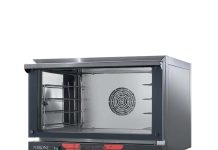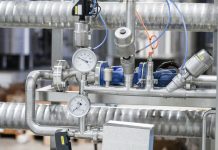 Food and beverages are heat treated for several reasons, among which the most frequent and important is to inactivate microbial population and therefore stabilize and prolong shelf life. Heat transfer has to be rapid and effective, in order to avoid as much as possible any damage to nutritive and organoleptic qualities of food, and also to save time and cut down fuelling costs, all important achievement for the food industry. Computer programs are available to design heat exchangers to the best possible efficiency. In a heat exchanger, thermal energy is transferred from one solid or fluid to another solid or fluid. In designing the equipment, heat transfer equations are applied to calculate this transfer of energy in order to carry it out efficiently and under controlled conditions. Besides good heat exchanger design, other factors are of paramount importance to obtain heat transfer efficiency; among them is the avoidance of any debris (either mineral or organic) accumulation on the heat exchanging surfaces. For this reasons, if water is used as the heat exchanging fluid, it has to be deionized. Food fluids (e.g. milk, sauces, etc.) treated with the equipment have to be thoroughly removed at the end of every processed batch with adequate cleaning procedures. If exchanging surfaces are not perfectly clean, heat exchange efficiency will be compromised. Some of the heat exchangers designs most utilized (see figures) in food industry applications are now described.
Food and beverages are heat treated for several reasons, among which the most frequent and important is to inactivate microbial population and therefore stabilize and prolong shelf life. Heat transfer has to be rapid and effective, in order to avoid as much as possible any damage to nutritive and organoleptic qualities of food, and also to save time and cut down fuelling costs, all important achievement for the food industry. Computer programs are available to design heat exchangers to the best possible efficiency. In a heat exchanger, thermal energy is transferred from one solid or fluid to another solid or fluid. In designing the equipment, heat transfer equations are applied to calculate this transfer of energy in order to carry it out efficiently and under controlled conditions. Besides good heat exchanger design, other factors are of paramount importance to obtain heat transfer efficiency; among them is the avoidance of any debris (either mineral or organic) accumulation on the heat exchanging surfaces. For this reasons, if water is used as the heat exchanging fluid, it has to be deionized. Food fluids (e.g. milk, sauces, etc.) treated with the equipment have to be thoroughly removed at the end of every processed batch with adequate cleaning procedures. If exchanging surfaces are not perfectly clean, heat exchange efficiency will be compromised. Some of the heat exchangers designs most utilized (see figures) in food industry applications are now described.
If one or both of the materials that are exchanging heat are fluids, flowing continuously through the equipment and acquiring/giving up heat, the process is very efficient, and these equipments are called “continuous flow heat exchangers”. This equipments are often employed to pasteurize milk or other beverages, and the heat exchanging fluid is almost exclusively water or water steam (depending on process temperature). One of the fluids is usually passed through pipes or tubes, and the other fluid is passed round or across these. At any point in the equipment, the local temperature differences and the heat transfer coefficients control the rate of heat exchange. The fluids can flow in the same direction through the equipment (parallel flow) or in opposite directions (counter flow), or they can also flow at right angles to each other (cross flow). Various combinations of these directions of flow can occur in different parts of the exchanger; in fact, most heat exchangers of this type have a mixed flow pattern. In parallel flow, the maximal temperature difference between the coldest and the hottest stream is at the entry to the heat exchanger, but at the exit the two streams approach each other’s temperature. In a counter flow exchanger, leaving streams can approach the temperatures of the entering stream of the other component and so counter flow exchangers are often preferred. To further improve heat exchange efficiency, the surface of the tubes can be “corrugated”, to extend the available surface and also to provoke dynamic turbulence in the fluids, improving thermal exchange up to 90% (especially in the case of low viscosity fluids). These equipments can in principle be used also to cool down beverages, e.g. using a sodium chlorine brine as exchanger fluid, but other approaches are more often used for this purpose.

Figure 1. Examples of different continuous flow heat exchangers. Modified from R.L. Earle
Plate heat exchangers
Another popular heat exchanger for fluids of low viscosity, such as milk, is the plate heat exchanger, where heating and cooling fluids flow through alternate tortuous passages between vertical plates as illustrated in figure 2. The plates are clamped together, separated by spacing gaskets, and the heating and cooling fluids are arranged so that they flow between alternate plates. Suitable gaskets and channels control the flow and allow parallel or counter current flow in any desired number of passes. A substantial advantage of this type of heat exchanger is that it offers a large transfer surface that is readily accessible for cleaning: in fact the banks of plates are usually arranged so that they may be taken apart easily. Overall heat transfer coefficients are high, in the order of 2400-6000 J m-2 s-1 °C-1.
Jacketed pans
In this kind of heat exchanger, the fluid (liquid food up to paste consistence food can be treated with this equipment) to be heated is contained in a vessel, which may also be provided with an agitator to keep the fluid moving across the heat transfer surface, to assure its homogeneous heating. Where there is no agitation, heat transfer coefficients are lower or even halved. The source of heat is commonly steam condensing in the vessel jacket: there must be the minimum of air within the steam in the jacket, because air hinders heat exchange. The pan itself can be made of cast iron, stainless steel, or copper. Heat transfer coefficients are not very high: depending on the pan material and on the viscosity of the fluid to be heated, can range from 300 J m-2 s-1 °C-1 (for pastes heated in stainless steel pans) to 1800 J m-2 s-1 °C-1 (for thin liquids heated in copper pans). Furthermore, usually this equipment only allows discontinuous food processing.
Heating coils immersed in liquids
In some food processes, where quick heating is required, a helical coil may be fitted inside the pan and steam admitted to the coil. This can give greater heat transfer rates than jacketed pans, because there can be a bigger heat transfer surface and also the heat transfer coefficients are higher for coils than for the pan walls. Examples of the overall heat transfer coefficient are quoted as: 300-1400 J m-2 s-1 °C-1 for  sugar and molasses solutions heated with steam using a copper coil, 1800 for milk in a coil heated with water, and 3600 for a boiling aqueous solution heated with steam in the coil.
sugar and molasses solutions heated with steam using a copper coil, 1800 for milk in a coil heated with water, and 3600 for a boiling aqueous solution heated with steam in the coil.
Scraped surface heat exchangers
Another kind of heat exchanger consists of a jacketed cylinder with an internal cylinder concentric to the first one,  and fitted with scraping blades (or shafts), as illustrated in figure 2. The blades rotate, causing the fluid to flow through the annular space between the cylinders with the outer heat transfer surface constantly scraped: the scraping shafts continuously remove the food from the walls, keeping it mixed and allowing optimal heat exchange. This equipment finds considerable use particularly for products of higher viscosity, and can be also used to drive away heat from the food instead of administering it (e.g. freezing of ice
and fitted with scraping blades (or shafts), as illustrated in figure 2. The blades rotate, causing the fluid to flow through the annular space between the cylinders with the outer heat transfer surface constantly scraped: the scraping shafts continuously remove the food from the walls, keeping it mixed and allowing optimal heat exchange. This equipment finds considerable use particularly for products of higher viscosity, and can be also used to drive away heat from the food instead of administering it (e.g. freezing of ice  creams and cooling of fats during margarine manufacture). Scraped surface exchangers can also be used to process foods sensitive to heat and/or to mechanical stress. Coefficients of heat transfer vary with speeds of rotation and with heated fluid characteristics, and are quite high, in the order of 900-4000 J m-2 s-1 °C-1.
creams and cooling of fats during margarine manufacture). Scraped surface exchangers can also be used to process foods sensitive to heat and/or to mechanical stress. Coefficients of heat transfer vary with speeds of rotation and with heated fluid characteristics, and are quite high, in the order of 900-4000 J m-2 s-1 °C-1.
Figure 2. Different heat exchanger equipments in section view. Modified from R.L. Earle
References
R.K. Shah and D.P. Sekulic, Fundamentals of Heat Exchanger Design. 2003. John Wiley & Sons
R.L. Webb and N.H. Kim, Principles of Enhanced Heat Transfer. 1994. Taylor & Francis Group
R.L. Earle, Unit Operations in Food Processing. Chapter 6 – Heat transfer Applications. 1983. The New Zealand Institute for Food Science and Technology Inc.








good article for foodscience students…love it
Comments are closed.